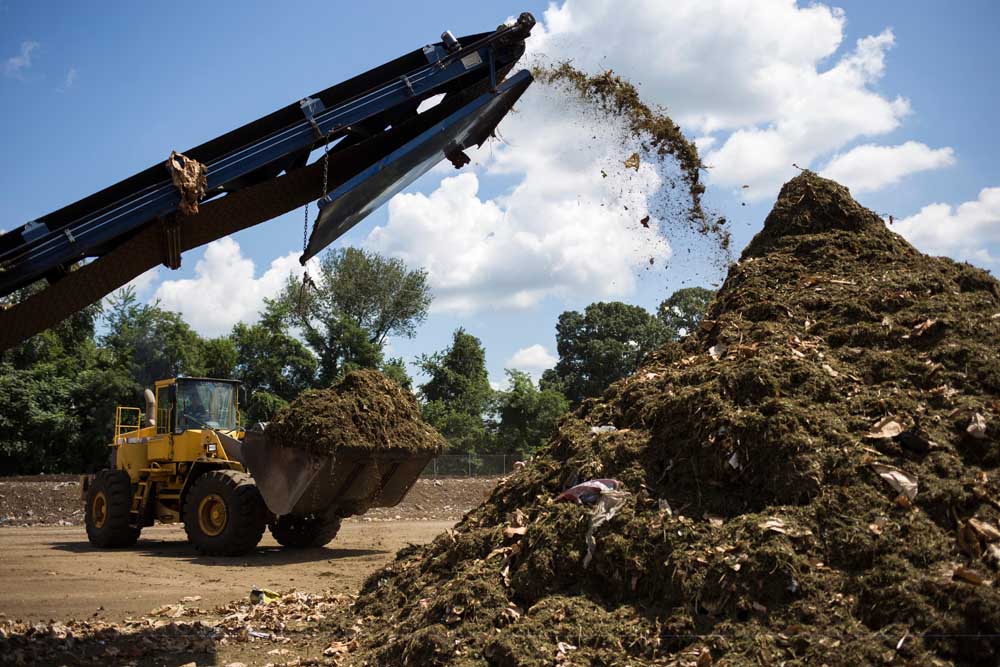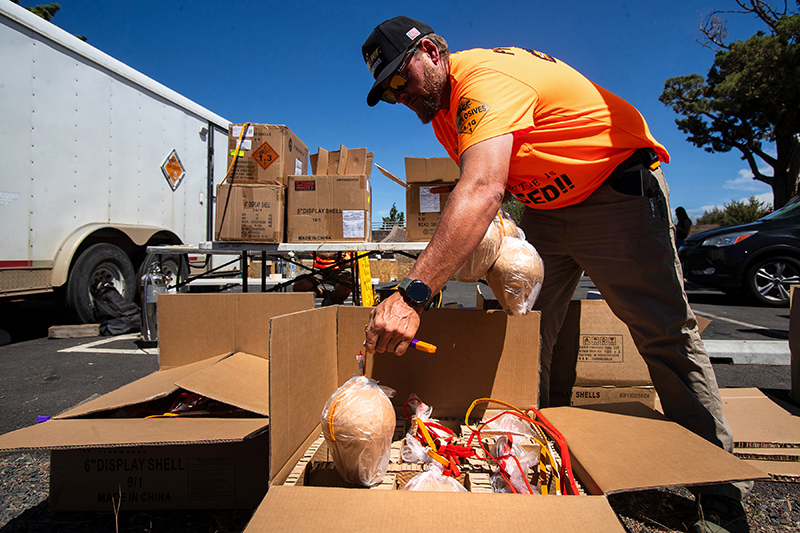Plastic food packaging has become composters’ greatest challenge
Published 5:11 am Friday, November 22, 2024

- Compost material is gathered at a county facility in Upper Marlboro, Maryland. MUST CREDIT: Brittany Greeson/The Washington Post
Slowly but surely, Americans are getting into composting. Curbside collection is on the rise, and more states and cities are making it mandatory to keep food scraps out of the garbage.
But the rise in popularity has led to an unintended consequence: Along with orange peels and eggshells, people are tossing twist ties, cling wrap, foam trays and other plastic food packaging into their collection bins. The result is contaminated compost.
As more people have bins in their kitchens, composters accustomed to only processing yard waste or relatively clean food scraps from supermarkets and restaurants are facing towering piles of banana peels and coffee grounds mixed with plastic that’s difficult and costly to remove. According to industry experts, contamination – the vast majority of which is from plastic – has quickly become composters’ greatest challenge.
Contaminated compost loses its value. Farmers, ranchers and landscapers avoid it for fear of polluting fields and gardens with plastic that degrades to produce tiny particles called microplastics. Once in water and soil, microplastics can enter the food chain – and our bodies.
“It’s getting harder and harder for the composters to deal with the contamination issues,” said Ron Alexander, a Raleigh, North Carolina-based composting consultant. “In certain areas of the country where we’ve pushed to recycle food waste, the infrastructure hasn’t caught up fast enough and they’ve reduced the quality of their product.”
For Alexander, the problem with plastic became clear several years ago when, in quick succession, he got complaining calls from officials in California, Washington and Oregon. In each of these states, municipal governments had increased food-scrap collection. The compost state transportation agencies relied on to protect roads from erosion was suddenly dotted with pieces of plastic.
“They said, ‘Yo, this stuff is dirty. Something has changed,’” Alexander recalled. “It was common sense – it’s food.”
The rise of plastic contamination in compost has followed a growing desire in the United States to keep food waste out of landfills, where it rots and produces methane gas, contributing to climate change. A 2023 study by the Environmental Protection Agency found emissions from food waste in the United States are roughly equal to more than 50 million cars on the road. Efforts to tackle the problem have focused on getting businesses to give away unsold but perfectly good food, before it reaches the trash. Several states and cities have also instituted mandatory composting measures.
Two years ago, California began requiring households and businesses to separate their food scraps from their trash – the largest effort of its kind in the country. By 2025, every city and county must reduce the organic waste that goes into landfills by 75 percent, composting it instead. Washington state is attempting to divert 75 percent of its food waste from landfills by 2030. Mandatory composting is underway in parts of New York City, where it will become law for households citywide next spring.
Although most composting facilities in the United States process only yard trimmings, curbside food-scrap collection has increased by 49 percent since 2021, according to a report released this year by Closed Loop Partners, a recycling investment fund. Gradually, more composters are shifting to accept household food scraps. But compost-facility owners view making the switch as risky, the study found, because they fear accepting food will bring higher levels of contamination, lowering the quality of their product and raising costs. On average, the study found, 21 percent of composters’ operating costs are spent on contamination removal, much of which is done by hand by workers on a sorting line.
Some large composters have tried to solve the problem with technology. There are machines that can pull food from its packaging and separators that can blow lightweight plastic bags and cling wrap off a compost pile. An often-used screening process can remove plastic pieces just three-eighths of an inch long. Cameras on garbage trucks can alert the driver to objects that don’t belong in compost. But industry experts said a perfect solution doesn’t exist yet, and small facilities often can’t afford these costs.
“This is an issue the industry has to, and is starting to, deal with, especially as there’s more of a push to divert the material from landfills,” said Leo Beckerman, director of operations at Zero Foodprint, a California-based nonprofit organization that helps farmers address climate change and promotes composting. Beckerman said he has heard stories of California composters finding car batteries in collection bins. But everyday plastic packaging, like the stickers on bananas and apples, is a more common source of headaches.
Even products that are designed to be compostable have become a problem.
People toss regular plastic cutlery, cups and plates into the compost, mistaking it for compostable products that belong there, Beckerman said. Consumers often can’t distinguish a certified compostable paper plate from one that has a plastic film on it, he said, and neither can composters. That kind of confusion has led some facilities to reject compostable packaging outright, concerned it will saddle them with more plastic contaminants.
“You have a lot of look-alikes out there,” said Frank Franciosi, executive director of the U.S. Composting Council, a trade association for composters. “My idea of nirvana would be all the products that are compostable are one color. And no other products that touch food are that color.”
The council plans to push Congress to pass national labeling requirements next year, Franciosi said. And because produce stickers are most often plastic, the council is also advocating for a global standard that would require companies everywhere to switch to compostable paper labels, using the same adhesive and soy-based ink. But the broader answer to the problem lies in better consumer education, Franciosi said. While some cities communicate regularly with residents about how to compost, including by refusing to pick up bins if they have plastic, others have taken a hands-off approach.
“The municipalities are trying their best to manage contamination. But they also need to manage the pushback from the residents,” said Brian Fleury, an executive vice president at Denali Water Solutions, which operates composting facilities across the country. “It becomes a real political challenge to tell a resident you’re going to leave their waste, especially organic waste that has odors.”
One obvious way to make cleaner compost is to reduce the use of plastic food packaging.
The European Union did that this year, approving a new law to ban single-use plastic packaging by 2030 for fresh fruit and vegetables, thin plastic grocery bags, individually plastic-wrapped condiments in fast food restaurants, and mini hotel toiletries. In the United States, 11 states enacted new measures this year to crack down on plastic packaging, including by restricting take-out bags and allowing restaurants to fill consumer-owned containers with ready-made food.
“As a state and nation, we need to stop manufacturing these materials. There isn’t a way to keep them out of the waste stream,” said Michele Young, who oversees composting in Santa Clara County, California.
While many Northern California cities and counties composted food scraps before the state’s law took effect two years ago, the compost mandate has led to a noticeable increase in plastic packaging in collection bins, Young said. The county gets a lot more cutlery, cups and plates than it did before. Some are compostable, but most are not.
“It’s a new level of processing challenge” for facilities trying to make clean compost, Young said. And for residents?
“They’re used to their garbage bag,” she said. “It’s a big behavior shift.”








